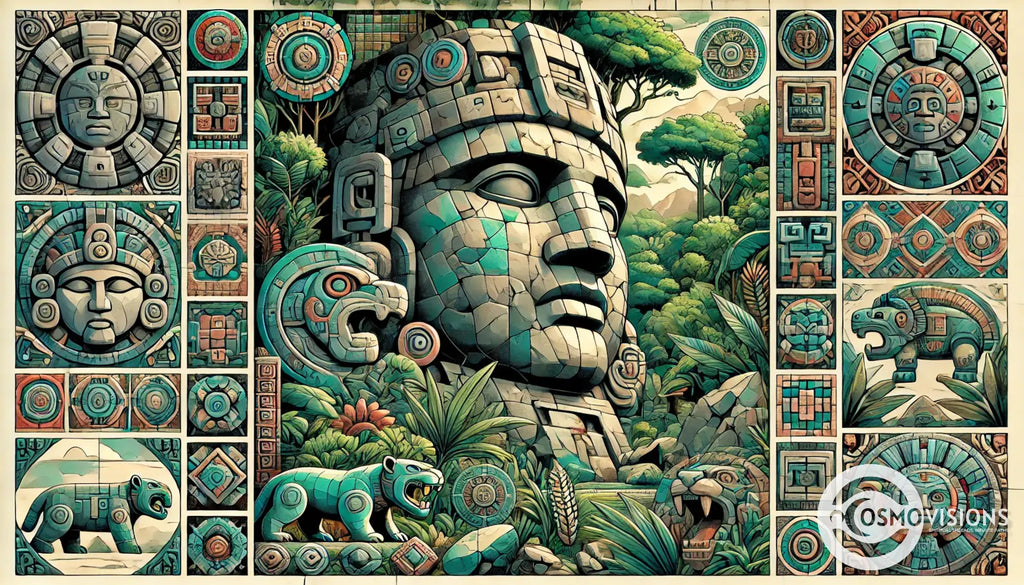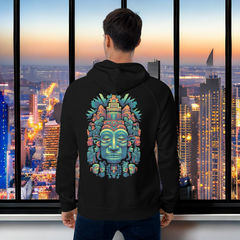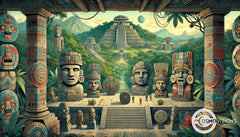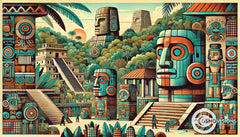Exploring the Enigmatic Olmec Colossal Heads: Ancient Marvels of MesoAmerica
Posted by Massimiliano Geraci

Discovering the Olmec Colossal Heads is like unlocking an ancient mystery. These massive stone sculptures portray human heads - but they aren’t ordinary. Dating back thousands of years, they offer a captivating glimpse into a major Mesoamerican civilization, the Olmecs, who flourished during the Preclassic period from about 1500 BCE to 400 BCE.
One crucial fact? The Olmec people transported ginormous basalt boulders from miles away to craft these colossal masterpieces. Why? And how did they achieve this incredible feat?
Our blog post unravels these mysteries, taking you on a journey through the symbolism, techniques, and archaeological significance behind the Olmec Colossal Heads. Get ready to be amazed.
Characteristics of Olmec Colossal Heads
The Olmec head sculptures exude striking individuality and style. Each sculpture conveys distinct facial features—parted lips, furrowed brows, or aquiline noses—intimating personas and dispositions.
The carvings evince symbolic regalia adorning rulers or elites, offering glimpses into Olmec sociopolitical hierarchies.

Individuality and style
The colossal heads are portraits of individuals, not deities. Each face is unique, revealing a sophisticated sculptural tradition. The first colossal head, discovered at Tres Zapotes in the 19th century, stands out with its massive dimensions, weight, and distinctive features. - Dr. Rebecca Gonzalez Lauck, Anthropologist
The Olmec carved their colossal heads with distinctive features. No two sculptures share the same facial expression or headdress style. These differences suggest the heads represent specific individuals - likely important rulers or elites.
Artisans carefully replicated natural human variations. Wrinkles, scars, and other imperfections highlight the realistic portrayals. The intricately carved headgear exhibits symbols of authority and power.
Symbolism and representation
The Olmec colossal heads symbolize individual rulers and represent the concept of rulership itself. They were arranged in lines or groups at major Olmec centres.
The heads may represent portraits of powerful olmec rulers. Deliberate vandalism on some heads points to ritual distancing. The colossal heads are stone representations of human heads sculpted from large basalt.
The olmec colossal heads represent olmec society's authority. The colossal heads were sculpted by olmec artists. The colossal heads sculpted from basalt show individuality and style.
Techniques and Materials Used in Sculpting Olmec Sculptures
Artisans extracted massive basalt boulders from quarries in the Sierra de los Tuxtlas mountains to create Olmec sculptures, particularly the colossal heads. They transported the stones to sites like San Lorenzo and La Venta over distances exceeding 80 kilometers (50 miles).
The sculptors carved intricate details onto the colossal heads using stone tools and abrasives.

Sourcing and transportation of basalt
The Olmec civilization exhibited remarkable skill in sourcing and transporting basalt for their colossal heads. They quarried the dense volcanic stone from Veracruz's Sierra de Los Tuxtlas mountains.
1. Large boulders of Cerro Cintepec basalt were extracted from the southeastern slopes of the mountain range.
2. The basalt came from a single geological source over 93 miles away from major Olmec cities like San Lorenzo and La Venta.
3. The Olmec people required significant human effort and resources to transport the massive stone pieces.
4. Moving the boulders was an incredible logistical challenge without beasts of burden or functional wheels.
5. River estuaries and coastal currents likely made waterborne transport impractical for the heavy basalt.
6. Olmec artisans developed specialized techniques for quarrying, shaping, and moving the stone over long distances.
7. The ability to source and transport basalt from remote locations showcased the Olmecs' organizational capabilities.
8. Acquiring this high-quality basalt demonstrated the importance placed on the colossal heads by Olmec society.
Carving methods
Olmec craftsmen sculpted colossal stone heads using sophisticated techniques. First, they roughed out the basalt boulders' shapes through direct percussion. Next, they refined facial features with smaller hammerstones and abrasives.
Finally, they drilled intricate details like pupils and wrinkles using reeds and wet sand.
Carved in stone, their art endures, whispering secrets of an ancient world.
Some colossal heads may have originated from reworked objects. Artisans transformed existing sculptures or modified rough-hewn blocks into towering portraits, imbuing lifeless rock with majesty and symbolism.
Influence of Olmec Art on Colossal Heads
Olmec art depicts a sophisticated understanding of anatomy and proportion. Their colossal heads exemplify this expertise, exhibiting meticulous carving of facial features and headdresses.
These sculptural marvels influenced later Mesoamerican cultures, inspiring the potbelly style seen in Southern Maya art.
The monumentality and artistry of the colossal heads demonstrate the Olmec people's advanced stone-carving abilities. Their influence radiated outward, shaping the artistic trajectories of subsequent civilizations across ancient Mexico.
Olmec sculptural techniques laid the foundations for an enduring legacy in Mesoamerican artistry.
Locations and Archaeological Significance
The colossal heads reveal ancient clues about San Lorenzo and La Venta. These sites were prominent Olmec centers where the giant sculptures were discovered. The Museo de Antropología and the Museo de Antropología de Xalapa are notable locations where several examples of the colossal heads are displayed.
San Lorenzo is an archaeological site in Veracruz state. La Venta is located in Tabasco. Both places contain ruins from the Olmec civilization’s heartland.

San Lorenzo
San Lorenzo, an archaeological site in Mexico’s Veracruz state, houses 10 colossal Olmec heads, including the renowned San Lorenzo colossal head. Sculpted between 900-600 BC, these monumental stone carvings stand in two parallel north-south lines.
The San Lorenzo heads are significant for their detailed craftsmanship and historical importance. They provide a comprehensive overview of these archaeological artifacts.
The most impressive is Colossal Head 1, a 25.3-ton basalt masterpiece measuring 2.84 meters high and 2.11 meters wide. Nearby is Head 2, weighing 20 tons and standing 2.69 meters tall.
These awe-inspiring monuments offer insights into Olmec society, artistry, and authority.
Carved from dense basalt quarried over 80 kilometers away, the colossal heads exemplify the Olmec’s sophisticated stone-working techniques and organizational capabilities. Their distinct individualized features suggest they portrayed elite Olmec rulers or spiritual leaders.
La Venta
Leaving behind San Lorenzo's enigmatic carved monoliths, explorers venture further into the heart of ancient Olmec territory -- the archaeological site of La Venta. Here, four colossal stone heads, monuments to an advanced civilization, reveal intricate carvings etched by master artisans.
These massive sculptures, weighing up to 24 tons, stand as awe-inspiring testaments to the Olmec's sophisticated stoneworking skills and reverence for symbolic representations.
At La Venta's ceremonial center, the colossal heads form part of an intricate complex, their imposing presence a striking reminder of this ancient culture's artistic prowess. The largest head measures an incredible 2.41 meters high, and its finely carved features offer a window into the Olmec's deep understanding of human anatomy and reverence for portraiture.
Tres Zapotes
Tres Zapotes, in the Gulf Lowlands, revealed two colossal heads. Monument A measures 1.47 meters high, 1.5 meters wide, 1.45 meters deep, and weighs 7.8 tons. Monument Q stands 1.45 meters high, 1.34 meters wide, 1.26 meters deep, and weighs 8.5 tons.
These massive basalt sculptures exemplify the artistic brilliance and monumental ambitions of the Olmec civilization. Their intricate carved features and colossal size underscore the authority and significance of Olmec rulers and elite figures.
Fashioning such immense monuments from dense volcanic rock required exceptional skill and resources, reflecting the sophisticated stone-working techniques mastered by Olmec artisans.
The Tres Zapotes heads encapsulate the profound spiritual and symbolic meaning infused into Olmec monumental art.
Impact on Understanding Mesoamerican Civilization
The Olmec colossal heads offer invaluable insights into Mesoamerican civilization. These monumental sculptures shed light on Olmec society, culture, and artistic achievements. They reveal advanced sculpting techniques and sophisticated symbolism.
Studying the colossal heads deepens our understanding of the origins and influences of later Mesoamerican cultures. Explore further to unravel more mysteries of these ancient marvels.
Insights into Olmec society and culture
The Olmec colossal heads provide invaluable insights into their advanced society and rich culture. These monumental sculptures showcase the Olmecs' sophisticated artistic abilities and their reverence for elite individuals.
The individualized facial features and elaborate headgear suggest these heads represent rulers or important figures. This highlights the existence of a complex hierarchical structure within the Olmec civilization.
The intricate carvings and symbolic adornments on the colossal heads reflect the Olmecs' spiritual and ritualistic practices. The subjects' expressions, often stern or pensive, evoke a sense of power and authority.
Influence on later Mesoamerican art
The Olmec colossal heads profoundly impacted subsequent Mesoamerican artwork. Archaeologists discovered the potbelly sculptural style in the Southern Maya region bore striking similarities to the Olmec heads.
This suggests the Olmec artisans' ingenuity radiated across ancient cultures, inspiring artistic expressions beyond their homelands.
Scholars theorize the monumental heads served as symbols of authority and rulership markers. Their distinct individualized features indicate they represented elite figures or deities revered by the Olmec people.
Conclusion
The Olmec colossal heads symbolize power, authority, and cultural identity. These massive sculptures stand as enduring testaments to ancient ingenuity. Crafted with skill and purpose, they inspire awe and provoke questions about the complex societies that created them.
Unlocking their mysteries enriches our comprehension of Mesoamerican civilizations' sophistication. Examining these marvels deepens appreciation for human creativity across millennia.
FAQs
1. What are the Olmec Colossal Heads?
The Olmec Colossal Heads are monumental stone sculptures—colossal masterworks of ancient Mexico—created by the Olmec culture in the Gulf Coast region, spanning the states of Veracruz and Tabasco. These massive carved heads, some reaching over 3 meters in height, are among the most iconic remnants of the Olmec heartland.
2. Where were the Olmec Colossal Heads discovered?
Many of the famous Olmec Colossal Heads were unearthed at major Olmec sites like San Lorenzo and La Venta in the Mexican states of Veracruz and Tabasco. Four heads from La Venta and one from San Lorenzo are now housed at the Museo Nacional de Antropología in Mexico City. Others remain in situ at their original locations.
3. What do the Olmec Colossal Heads depict?
The Olmec Colossal Heads are thought to be portrait representations -- the sculpted faces likely depicting important individuals or rulers who held authority among the Olmec people. The heads display distinctive Olmec styles, with unique headgear and facial features that offer insights into Olmec culture and artistic traditions.
4. How were the Olmec Colossal Heads created?
Sculpting the heads from single basalt boulders was an incredible feat of ancient engineering and artistry. The Olmec people carefully carved the massive stone heads using specialized tools and techniques...transporting the multi-ton sculptures over great distances added to the monumental achievement.
5. Why were the Olmec Colossal Heads buried?
Many of the heads were buried, their original contexts and meanings obscured over time. Some theories suggest the heads were intentionally interred as part of ritual practices or to commemorate important events. The act of burying these colossal sculptures remains one of the enduring mysteries surrounding the Olmec culture.
6. What is the significance of the Olmec Colossal Heads?
The Olmec Colossal Heads are iconic symbols of the ancient Olmec civilization, one of the earliest complex societies in Mesoamerica. Their sheer size and artistry have captivated archaeologists, offering a window into the sophisticated cultural and technological achievements of the Olmec people who inhabited this region over 3,000 years ago.






















